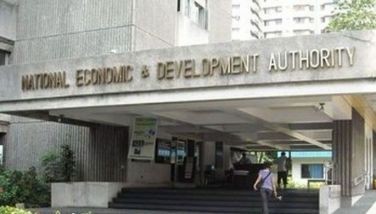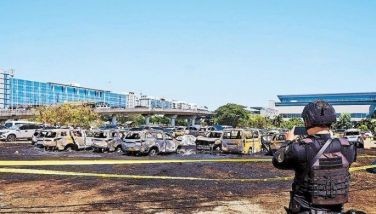Mayon explodes; 5 dead
LEGAZPI CITY, Philippines – At daybreak yesterday, a dense fog enveloped Mayon volcano, making some of the climbers decide to turn back as they reached an elevation of 1,600 meters.
But it was too late.
Kenneth Jesalva, 21, one of three Filipino guides, heard what seemed to be a hail of coconuts falling. This was followed by the rumble of rocks crashing down.
Then the smoldering rocks, some as large as tables, struck them. Hit on the back and his left foot, Jesalva sought shelter in a secluded area, where he watched helplessly as the foreign trekkers they were guiding were buried in the volcanic rocks.
Four tourists – three Germans and a Spaniard – and one of Jesalva’s fellow guides were killed. Seven others were injured, including four Thais and an Austrian woman.
Up to 27 foreigners and their local guides were on the slopes of Mayon volcano at around 5:45 a.m. yesterday when it sent up a thick column of ash 500 meters into the air, in what volcanologists described as a phreatic explosion.
Rescue teams and helicopters were sent to Mayon following the explosion to retrieve the dead.
Authorities identified the fatalities as Joanne Edosa, Roland Pietieze and Furian Stelter – all German nationals – and Farah Frances, a Spaniard who resided in Germany. The local guide was identified as Jerome Berin.
Among those rescued were Austrian Sabine Strohberger and Jesalva, one of the three local tour guides of the climbers.
Jesalva said the climbers were hit by huge rocks, some “as big as a living room,†that suddenly came raining down on them.
Jesalva said he was in the group that spent the night on the mountain, when the 2,460-meter volcano rumbled back to life early in the morning.
Though injured, Jesalva managed to scamper to safety and rushed back to the base camp to call for help.
“The rocks that hit us were glowing hot. Fortunately I was able to take cover in a huge boulder,†he said.
The local tour operator Marti Calleja said his company had sought help to rescue five foreigners who had gone to climb Mayon with his outfit’s guides shortly before the explosion.
“It rained like hell with stones. It was sudden and there was no warning,†Calleja said.
He added the group was trapped about half a kilometer below the crater.
What happened to the danger zone?
Albay Gov. Joey Salceda ordered rescue teams and helicopters to be sent to Mayon.
He said initial reports indicated at least eight were injured from a group of about 27 mountaineers who were caught by surprise by the sudden eruption.
“The injured are all foreigners... They cannot walk. If you can imagine, the boulders there are as big as cars. Some of them slid and rolled down. We will rappel the rescue team, and we will rappel them up again,†Salceda said.
He said an Austrian mountaineer and two Spaniards were among those rescued with small bruises.
Cedric Daep, chief of Albay Public Safety and Emergency Management Office, said they managed to rescue some of the survivors.
Daep identified two foreigners as Nithi Ruangpisit and Tanut Ruchipiyrak, both Thai nationals.
Other mountaineers from Thailand who were injured were identified as Udome Kiat, Utan Ruchi, and a certain Boonchi and Benjama.
Three of the injured locals were identified as Bernard Hernandez, Nicanor Mabao and Caluxto Balunso.
Salceda lamented the lack of coordination among local mountaineer guides.
“They only coordinate with us when there is an emergency,†he said. “We don’t even have the list of foreign and local tourists who are going up the volcano.â€
Malacañang, on the other hand, is seeking an explanation over the incident.
“That’s what the President ordered to ask – the parameters of the danger zone. And as far as our information has yielded, even if the local government restricts tourist activities there, they have to seek permission because there are guides that just go up without asking permission,†deputy presidential spokesperson Abigail Valte said.
Valte said the President tasked Executive Secretary Paquito Ochoa Jr. to find out from the local government why groups had managed to get within the six-kilometer permanent danger zone.
“What does it mean when it’s a permanent danger zone? That prohibits permanent settlement in the area but activity is not prohibited. What we understand is the local government has restricted activity and precisely, the President wanted to know the parameters because the six-kilometer danger zone is something that is enforced by the local government. So they are the ones in charge of enforcing to make sure that nobody gets hurt,†Valte said.
Valte said the focus now is to attend to the injured and “facilitating the repatriation of the fatalities.â€
“There are already two Air Force choppers that have been deployed to retrieve the casualties,†Valte said.
Asked who should be held responsible for the incident, Valte said: “We’ll defer judgment on that before being faced with the full facts.â€
Eruption was normal
Philippine Institute of Volcanology and Seismology (Phivolcs) director Renato Solidum said yesterday’s eruption was normal for the restive Mayon.
The volcano, renowned for its almost perfect cone, has erupted about 40 times during the last 400 years.
Despite the risks, Mayon and its near-perfect cone is a favorite spot for volcano watchers. Most enjoy the occasional nighttime spectacle of the rim lit by flowing lava, viewing it from the safety of hotels in Legazpi City.
The volcano has a trail to the crater, though it is steep and strewn with rocks and debris from past eruptions.
In 2010, thousands of residents moved to temporary shelters when Mayon ejected ash in an eight-kilometer zone surrounding the crater.
Solidum said that no alert was raised for the volcano following the latest eruption and no evacuation was being planned.
Climbers are not allowed when an alert is up, and the recent calm may have encouraged this week’s trek.
Clouds have cleared over the volcano, which was quiet later in the morning following the explosion that lasted only 78 seconds, officials said.
The explosion produced a grayish ash column that reached 500 meters above the crater but the ash fall did not reach populated areas, Phivolcs said.
Solidum said Mayon volcano remains under Alert Level 0 status, which means that “no eruption in foreseeable future.â€
However, the public is barred from entering the six-kilometer radius Permanent Danger Zone as phreatic explosions and ash puffs may occur without precursors.
A phreatic explosion occurs when magma heats ground or surface water. This can be accompanied by carbon dioxide or hydrogen sulphide gas emissions.
Phivolcs said it is not raising the alert level at Mayon, as there were no other abnormalities recorded at the volcano so far.
“There is no magma activity. Essentially what happened today is a normal process of a steam-driven explosion,†Solidum said.
Residents in towns around Mayon said they were surprised by the sudden activity, which came as many were having breakfast.
“It was so sudden that many of us panicked,†said Jun Marana, a 46-year-old bus driver and father of two.
“When we stepped out we saw this huge column against the blue sky,†he said.
Marana said the ash column was dispersed by winds after about an hour, but that he was not taking chances and was prepared to leave his home. – Aurea Calica, Celso Amo, Helen Flores, Ricky Bautista, Francis Elevado, Rainier Allan Ronda, AP
- Latest
- Trending




























